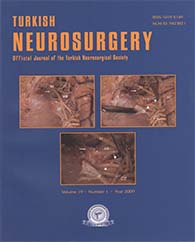Turkish Neurosurgery
2009 , Vol 19 , Num 1
1,2,4Dışkapı Yıldırım Beyazıt Eğitim ve Araştırma Hastanesi, 2. Beyin Cerrahisi Kliniği, Ankara, Turkey
3Gazi Üniversitesi Tıp Fakültesi, Nükleer Tıp Departmanı, Ankara, Turkey Crossed aphasia (CA) refers to aphasia occurring after right brain damage in right handers. In the literature, numerous CA cases following cerebral ischemia have been reported, but few met the criteria for a prompt diagnosis. The authors present the case of a 52-year-old woman with SAH caused by a right middle cerebral artery (MCA) saccular aneurysm who developed non-fluent aphasia characterized by reduced verbal output, word-finding disturbances and phonemic paraphasias in both oral and written language. 99mTc-HMPAO SPECT was also consistent with right parieto-temporal and frontoparietal ischemia with crossed cerebellar diaschisis on the right cerebellum. Adiagnosis of CA was made. One year follow-up showed improvement in communication skills but persistent right fronto-temporo-parietal ischemia. Cerebral vasospasm after aneurysmal SAH symptomatology may vary from motor and sensory disturbances to cognitive disabilities. Aphasia developing after cerebral ischemia of the right hemisphere in a righthand dominant patient following vasospasm may be a misleading symptom for the localization of the insult. Keeping a high index of suspicion may help in making the correct diagnosis. The changes in the perfusion patterns of cerebellum as assessed by SPECT study during the acute and recovery phases suggests the involvement of cerebellum in language functions. Keywords : Crossed aphasia, Subarachnoid hemorrhage, Cerebral vasospasm, SPECT, Cerebellum
Corresponding author : Kazım Yiğitkanlı, kazimyigitkanli@gmail.com
3Gazi Üniversitesi Tıp Fakültesi, Nükleer Tıp Departmanı, Ankara, Turkey Crossed aphasia (CA) refers to aphasia occurring after right brain damage in right handers. In the literature, numerous CA cases following cerebral ischemia have been reported, but few met the criteria for a prompt diagnosis. The authors present the case of a 52-year-old woman with SAH caused by a right middle cerebral artery (MCA) saccular aneurysm who developed non-fluent aphasia characterized by reduced verbal output, word-finding disturbances and phonemic paraphasias in both oral and written language. 99mTc-HMPAO SPECT was also consistent with right parieto-temporal and frontoparietal ischemia with crossed cerebellar diaschisis on the right cerebellum. Adiagnosis of CA was made. One year follow-up showed improvement in communication skills but persistent right fronto-temporo-parietal ischemia. Cerebral vasospasm after aneurysmal SAH symptomatology may vary from motor and sensory disturbances to cognitive disabilities. Aphasia developing after cerebral ischemia of the right hemisphere in a righthand dominant patient following vasospasm may be a misleading symptom for the localization of the insult. Keeping a high index of suspicion may help in making the correct diagnosis. The changes in the perfusion patterns of cerebellum as assessed by SPECT study during the acute and recovery phases suggests the involvement of cerebellum in language functions. Keywords : Crossed aphasia, Subarachnoid hemorrhage, Cerebral vasospasm, SPECT, Cerebellum





